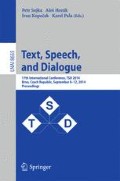Abstract
Being based on English language, existing systems of part-of-speech induction prioritize the contextual and distributional features “external” to the word and attribute somewhat secondary importance to features derived from word’s “internal” morphologic and orthotactic regularities. Here we present some preliminary empirical results supporting the statement that simple “internal” features derived from frequencies of occurrences of character n-grams can substantially increase the V-measure of POS categories obtained by repeated bisection k-way clustering of tokens contained in Multext-East corpora. Obtained data indicate that information contained in suffix features can furnish c(l)ues strong enough to outperform some much more complex probabilist or HMM-based POS induction models, and that this can especially be the case for Western Slavic languages.
Access this chapter
Tax calculation will be finalised at checkout
Purchases are for personal use only
Preview
Unable to display preview. Download preview PDF.
References
Berg-Kirkpatrick, T., Bouchard-Côté, A., de Nero, J., Klein, D.: Painless unsupervised learning with features. In: Human Language Technologies: The 2010 Annual Conference of the North American Chapter of the Association for Computational Linguistics, pp. 582–590 (2010)
Biemann, C.: Unsupervised part-of-speech tagging employing efficient graph clustering. In: Proceedings of the 21st International Conference on Computational Linguistics and 44th Annual Meeting of the Association for Computational Linguistics: Student Research Workshop, pp. 7–12 (2006)
Brown, P.F., Desouza, P.V., Mercer, R.L., Della Pietra, V.J., Lai, C.: Class-based n-gram models of natural language. Computational Linguistics 18(4), 467–479 (1992)
Christodoulopoulos, C., Goldwater, S., Steedman, M.: Two Decades of Unsupervised POS induction: How far have we come? In: Proceedings of the 2010 Conference on Empirical Methods in Natural Language Processing, pp. 575–584 (2010)
Clark, A.: Combining distributional and morphological information for part of speech induction. In: Proceedings of the Tenth Conference on European Chapter of the Association for Computational Linguistics, vol. 1, pp. 59–66 (2003)
Elman, J.L.: Representation and structure in connectionist models (1989)
Erjavec, T.: MULTEXT-East: Morphosyntactic resources for Central and Eastern European languages. Language Resources and Evaluation 46(1), 131–142 (2012)
Goldwater, S., Griffiths, T.: A fully Bayesian approach to unsupervised part-of-speech tagging. In: Annual Meeting of Association of Computational Linguistics, vol. 45, p. 744 (2007)
Graca, J., Ganchev, K., Taskar, B., Pereira, F.: Posterior vs. parameter sparsity in latent variable models. In: Advances in Neural Information Processing Systems, vol. 22, pp. 664–672 (2009)
Hromada, D.D.: Conditions for cognitive plausibility of computational models of category induction. In: Laurent, A., Strauss, O., Bouchon-Meunier, B., Yager, R.R. (eds.) IPMU 2014, Part II. CCIS, vol. 443, pp. 93–105. Springer, Heidelberg (2014)
Johnson, M.: Why doesnt EM find good HMM POS-taggers. In: Proceedings of the 2007 Joint Conference on Empirical Methods in Natural Language Processing and Computational Natural Language Learning (EMNLP-CoNLL), pp. 296–305 (2007)
Karypis, G.: CLUTO-a clustering toolkit (2002)
Rosenberg, A., Hirschberg, J.: V-measure: A conditional entropy-based external cluster evaluation measure. In: Proceedings of the 2007 Joint Conference on Empirical Methods in Natural Language Processing and Computational Natural Language Learning (EMNLP-CoNLL), vol. 410, p. 420 (2007)
de Saussure, F.: Cours de linguistique générale. Payot, Paris (1922)
Schütze, H.: Part-of-speech induction from scratch. In: Proceedings of the 31st Annual Meeting on Association for Computational Linguistics, pp. 251–258 (1993)
Slobin, D.: Cognitive prerequisities for acquisition of grammar. In: Studies of Child and Language Development, pp. 175–208 (1973)
Author information
Authors and Affiliations
Editor information
Editors and Affiliations
Rights and permissions
Copyright information
© 2014 Springer International Publishing Switzerland
About this paper
Cite this paper
Hromada, D.D. (2014). Comparative Study Concerning the Role of Surface Morphological Features in the Induction of Part-of-Speech Categories. In: Sojka, P., Horák, A., Kopeček, I., Pala, K. (eds) Text, Speech and Dialogue. TSD 2014. Lecture Notes in Computer Science(), vol 8655. Springer, Cham. https://doi.org/10.1007/978-3-319-10816-2_6
Download citation
DOI: https://doi.org/10.1007/978-3-319-10816-2_6
Publisher Name: Springer, Cham
Print ISBN: 978-3-319-10815-5
Online ISBN: 978-3-319-10816-2
eBook Packages: Computer ScienceComputer Science (R0)

